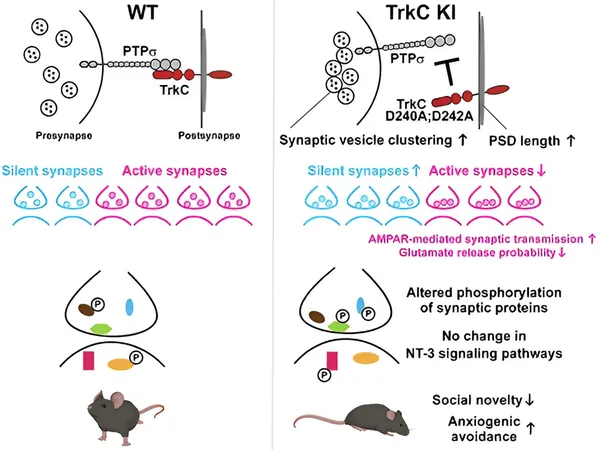
Breakthrough in Brain Cell Research Offers Hope for Anxiety Disorder Treatments
2024-10-11
Author: Noah
Exciting New Research
Exciting new research led by scientists from the Université de Montréal and its partner institution, the Montreal Clinical Research Institute (IRCM), has unveiled a groundbreaking discovery that could reshape our understanding of anxiety disorders. The team, under the leadership of Hideto Takahashi, director of IRCM's synapse development and plasticity research unit, has identified a protein complex that plays a critical role in the organization and function of brain cell connectivity and specific cognitive behaviors.
Collaborative Findings
Collaborating with experts from York University and Tokushima University, the findings were published in The EMBO Journal, shedding light on the often-murky mechanisms behind neuropsychiatric conditions. "The research serves two key purposes," Takahashi emphasizes. "One is to uncover new molecular mechanisms for communication between brain cells, and the other is to create a unique animal model that mimics anxiety disorders, including behaviors akin to panic disorder and agoraphobia. This is significant in our quest for new therapeutic avenues."
Prevalence of Anxiety Disorders
Anxiety disorders, autism, and schizophrenia are not merely niche concerns; they rank among the most pressing health challenges faced in Canada and around the globe. Despite their prevalence, developing effective drugs for these conditions has been fraught with difficulty, largely due to the brain's complex nature.
Importance of Synapses
The synapse – the junction where two neurons communicate – is crucial for relaying signals in the brain. When these synaptic connections falter, particularly in excitatory synapses that activate neighboring neurons, it can precipitate a cascade of mental health issues.
Discovery of TrkC-PTPσ Complex
Previously, Takahashi’s research team made a pivotal discovery regarding a novel protein complex called TrkC-PTPσ, which resides exclusively in excitatory synapses. Of particular interest is the potential link between the genes encoding components of this complex – NTRK3 and PTPRS – and conditions such as anxiety disorders and autism. However, how this complex influences synapse development remained largely unknown.
Research Findings on Synapse Maturation
In the latest study, led by doctoral student Husam Khaled, the researchers revealed that the TrkC-PTPσ complex is integral to the structural and functional maturation of excitatory synapses. It achieves this by regulating the phosphorylation of various synaptic proteins, critical modifications that influence neuron behavior. Strikingly, when this complex is disrupted in genetically altered mice, distinct behavioral anomalies occur, including pronounced anxiety and social interaction difficulties.
Role of Neurons and Synapses
Neurons, the fundamental units of the brain and nervous system, function by sending and receiving signals to orchestrate bodily and cognitive activities. Synapses serve as the bridges facilitating this vital communication. However, if synapses or their components fail, it can lead to serious cognitive and psychological disorders.
Genetic Engineering and Behavioral Analysis
Through meticulous genetic engineering, the researchers created mice displaying specific mutations that impair the TrkC-PTPσ complex. This innovative approach revealed that this protein complex is crucial for maintaining proper synaptic structure and organization. Advanced imaging techniques further illuminated the mutant mice’s brains, exposing abnormal synapse configurations and an abundance of inactive synapses leading to disrupted signal transmission.
Conclusions and Future Prospects
The behavioral analysis of these mutant mice highlighted a stark increase in anxiety levels, particularly in new or unfamiliar environments, paired with significant social interaction deficits.
As scientists continue to unravel the mysteries of brain connectivity and its relation to mental health, this research not only paves the way for understanding anxiety disorders more deeply but also holds promise for developing effective treatment strategies that could benefit millions worldwide. Keep an eye on these developments—what could this mean for the future of mental health treatments?









 Brasil (PT)
Brasil (PT)
 Canada (EN)
Canada (EN)
 Chile (ES)
Chile (ES)
 España (ES)
España (ES)
 France (FR)
France (FR)
 Hong Kong (EN)
Hong Kong (EN)
 Italia (IT)
Italia (IT)
 日本 (JA)
日本 (JA)
 Magyarország (HU)
Magyarország (HU)
 Norge (NO)
Norge (NO)
 Polska (PL)
Polska (PL)
 Schweiz (DE)
Schweiz (DE)
 Singapore (EN)
Singapore (EN)
 Sverige (SV)
Sverige (SV)
 Suomi (FI)
Suomi (FI)
 Türkiye (TR)
Türkiye (TR)